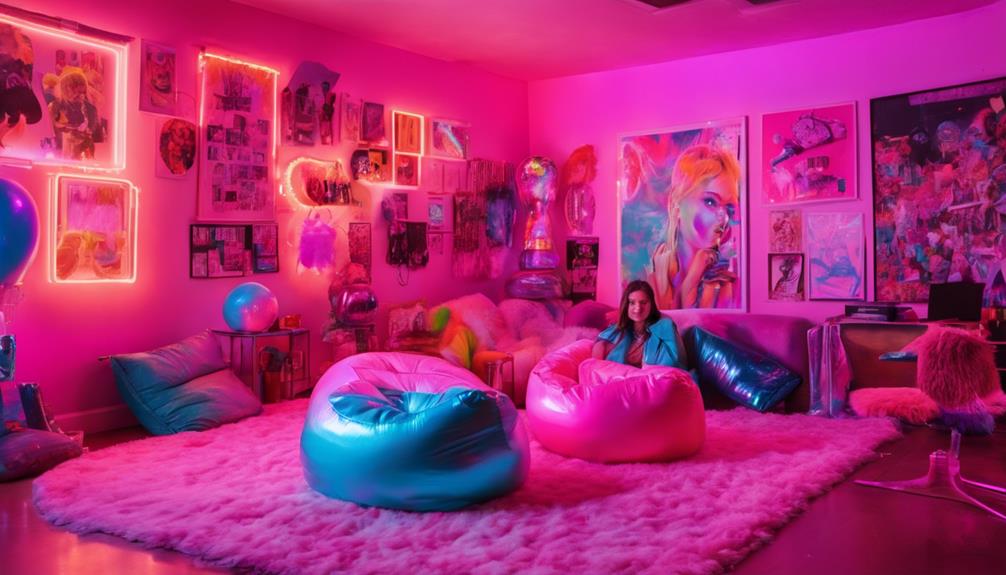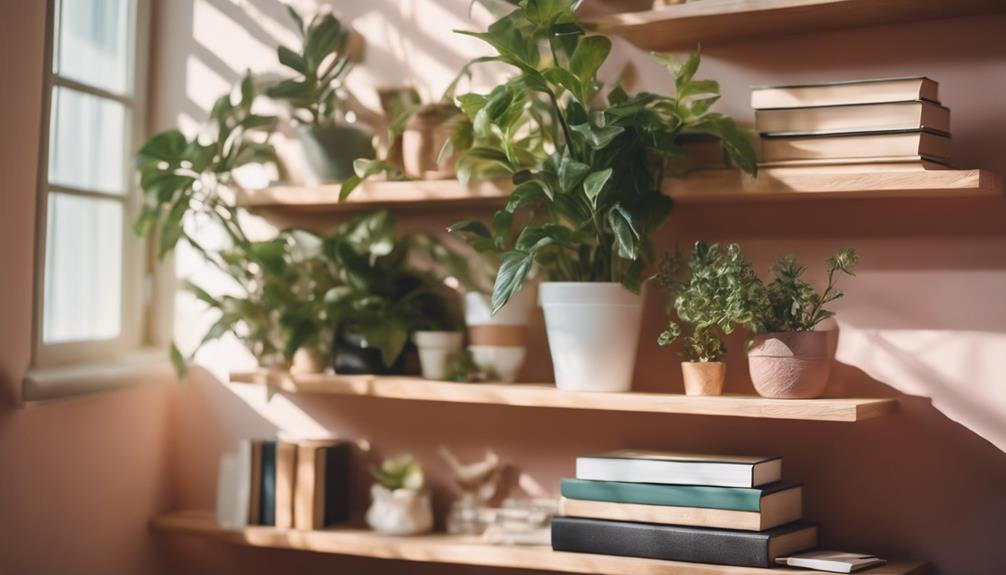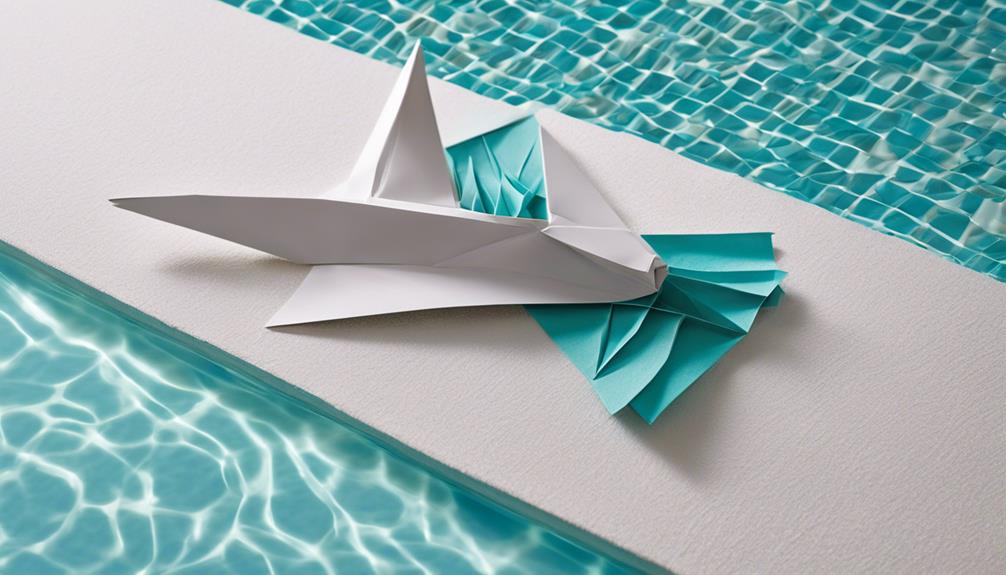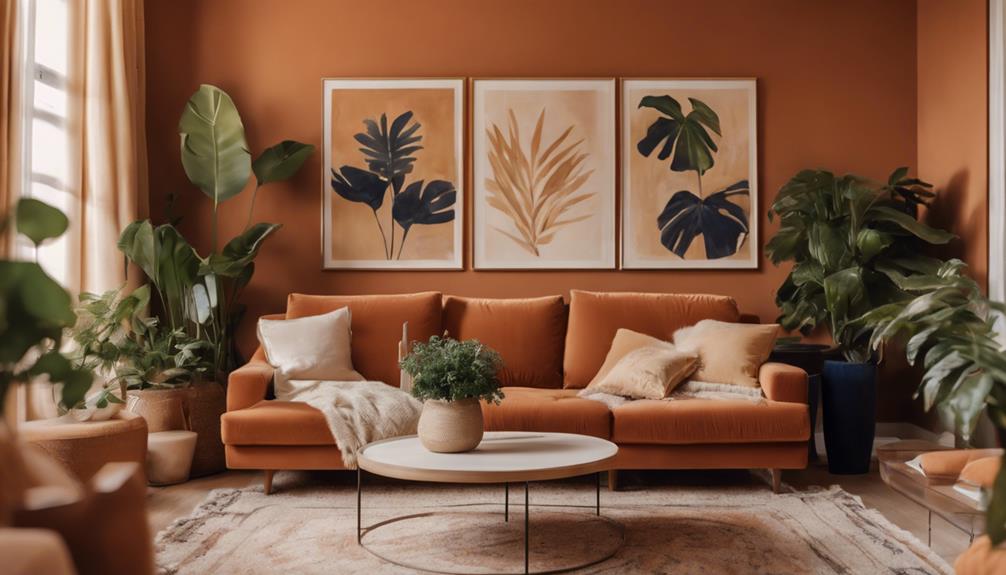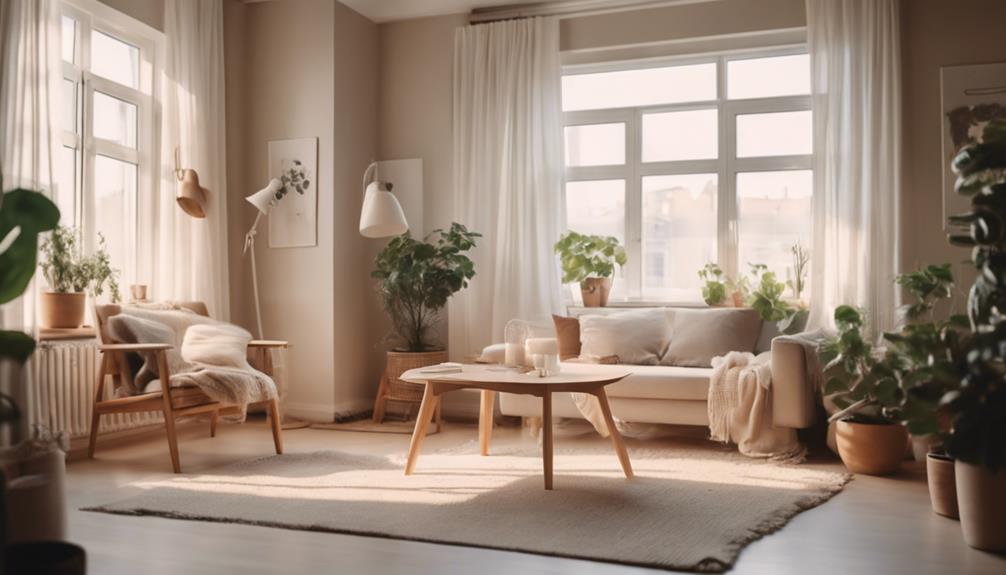To create a Y2K-inspired room, think vibrant colors and playful textures. Use bold shades like hot pink and turquoise, and mix in soft pastels for balance. Cozy bean bag chairs and glittery lava lamps invite relaxation while adding nostalgia. Illuminate your space with neon lights and disco ball pendants for that retro vibe. Incorporate fun elements like beaded curtain dividers and vintage CD displays for a personal touch. Don't forget about flooring that pops, like checkerboard vinyl or faux fur rugs. Embrace this lively style to capture the spirit of the era, and there's more inspiration waiting for you!
Key Elements
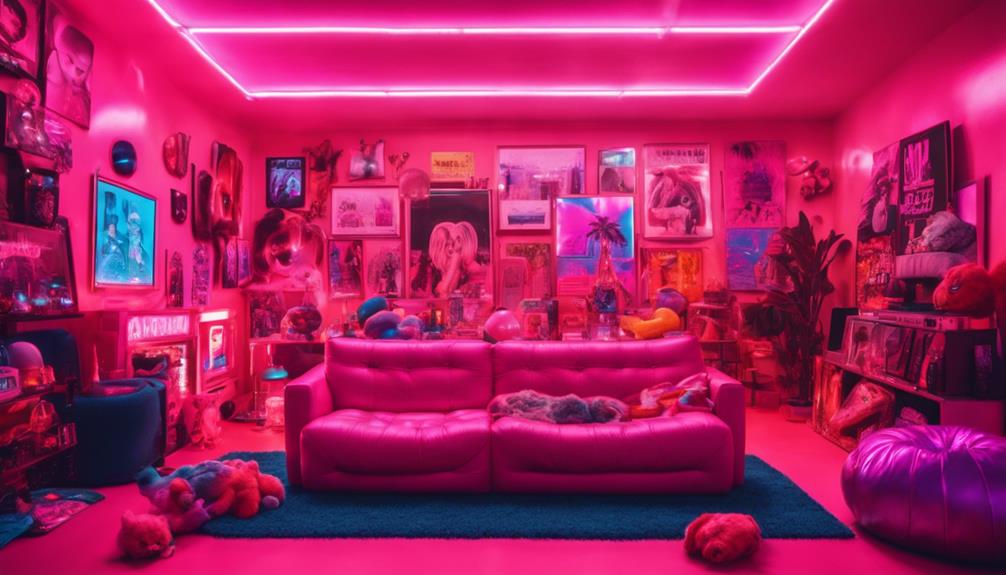
When you're designing your Y2K-inspired room, the color scheme sets the tone for the entire space.
Vibrant hues and bold materials create that playful vibe you're after, while various textures add depth and interest.
Color Scheme
The Y2K color scheme bursts with vibrant neons and playful pastels, creating a lively atmosphere that captures the spirit of the early 2000s. To achieve that quintessential Y2K aesthetic, focus on bold shades like hot pink, turquoise, and lime green. These vibrant colors inject energy into any space, making it feel youthful and dynamic.
Incorporating metallics like silver and chrome can elevate your decor, lending a futuristic touch that complements the playful palette. You might also consider bold patterns such as checkerboards and swirls, which enhance the energetic vibe and contribute to a maximalist aesthetic.
To keep things balanced, soft, muted tones can serve as a counterpoint to the brighter hues. This approach helps create a cohesive color scheme without overwhelming the senses. Additionally, tie-dye patterns and iridescent designs add a nostalgic yet trendy flair, drawing inspiration from the pop culture of the early 2000s.
Mixing these elements won't only embrace the Y2K vibe but also guarantee your space feels fresh and inviting. So, get ready to transform your room into a colorful reflection of this iconic era!
Materials
To bring your Y2K color scheme to life, focus on incorporating vibrant materials that enhance the playful and cozy atmosphere of your space.
Start with plush textiles like velvet and faux fur. These soft, inviting fabrics not only create a warm environment but also add a touch of whimsy. Look for bold patterns, such as animal prints or tie-dye, to infuse even more fun into your decor.
Next, don't overlook the impact of metallic elements. Silver and chrome finishes can elevate your furniture and accessories, lending a futuristic vibe that's quintessentially Y2K.
Think about incorporating items like a sleek chrome coffee table or metallic shelving to reflect light and create visual interest.
Textures
Incorporating a variety of textures transforms your Y2K room into a vibrant and inviting space that resonates with eclectic style. To capture this aesthetic, think about using iconic materials like velvet and faux fur. These textures not only add a luxurious and cozy feel but also enhance the visual interest of your design elements.
Layering is key—combine shaggy rugs with smooth surfaces such as glass or acrylic furniture to create a dynamic contrast that's visually appealing. Add bright, graphic prints on textiles, featuring bold animal and floral patterns, to embrace the maximalist approach central to Y2K decor.
Don't shy away from mixing plush cushions with shiny metallic accents; this layering effect adds depth and character, making your space truly vibrant.
Essential Fixtures and Furniture
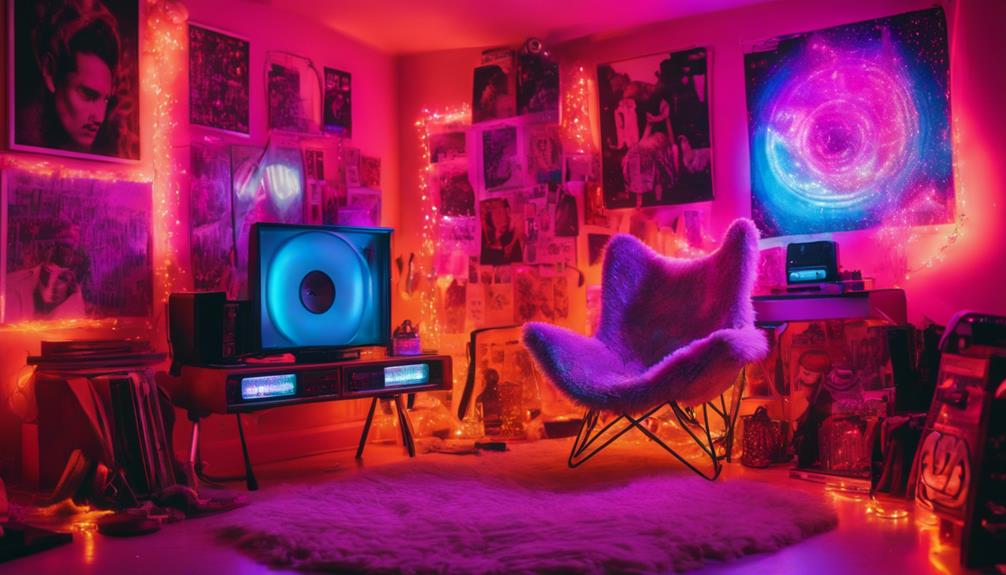
When it comes to Y2K room decor, essential fixtures and furniture are all about comfort and personality.
You can't go wrong with cozy bean bag chairs and fuzzy floor cushions that invite relaxation.
Plus, adding glittery lava lamps won't only light up your space but also capture that fun, nostalgic vibe.
Bean Bag Chairs
Bean bag chairs are a must-have for creating that laid-back Y2K vibe in your room, offering both style and comfort. These iconic pieces of furniture embody the casual feel of the early 2000s, making them perfect additions to your Y2K room decor. Available in vibrant colors and bold patterns, bean bag chairs can complement the bright neons and playful aesthetics typical of this design era.
Their lightweight and versatile nature allows you to easily rearrange them to suit your activities, whether you're lounging, gaming, or hanging out with friends. The unique filling of polystyrene beads molds to your body, ensuring maximum comfort while you relax. Plus, many modern bean bag chairs are made from eco-friendly materials, making them a stylish yet sustainable choice for your space.
Incorporating bean bag chairs into your room not only enhances the overall look but also adds a fun, inviting atmosphere that encourages relaxation. So, go ahead and pick a few in your favorite vibrant colors to create a cozy corner that perfectly captures that nostalgic Y2K essence!
Fuzzy Floor Cushions
Fuzzy floor cushions bring a cozy, inviting touch to your Y2K room, perfectly blending comfort with vibrant style. Made from soft materials like faux fur or plush fabrics, these cushions offer a delightful seating option that aligns seamlessly with the Y2K aesthetic. You'll love how they come in a variety of bold colors and playful shapes, enhancing the maximalist vibe of your interior design.
Not only do fuzzy floor cushions provide extra seating for gatherings, but they also double as stylish decorative accents. Their versatility allows you to easily rearrange them for lounging spaces or create a more dynamic layout. You can choose from oversized round cushions or those featuring iconic Y2K motifs, appealing to both your sense of comfort and nostalgia.
Incorporating these cushions into your space adds an eclectic mix of textures, which is essential for achieving that distinctive Y2K feel. By selecting cushions that reflect your personality and style, you can elevate your room's decor while enjoying the cozy comfort they offer. Embrace the playful spirit of the Y2K era with fuzzy floor cushions that make your space truly unique!
Glittery Lava Lamps
Glittery lava lamps are a must-have fixture in any Y2K-themed room, effortlessly blending retro charm with a playful ambiance. These iconic pieces of Y2K decor combine whimsical design with mesmerizing light displays, making them the perfect addition to your space. Available in various colors and glitter combinations, they can elevate the vibrant atmosphere you're aiming for.
Typically featuring a classic glass base and a wax-filled chamber, glittery lava lamps operate by heating the wax, creating dynamic movement that captures attention. Whether you choose a modern LED version for energy efficiency or stick with a nostalgic incandescent model, these lamps maintain their unique appeal.
Incorporating lava lamps into your Y2K decor not only adds a nostalgic touch but also serves as a conversation starter. They reflect the delightful blend of kitsch and creativity from the early 2000s, making them an essential fixture in your room.
Lighting Ideas
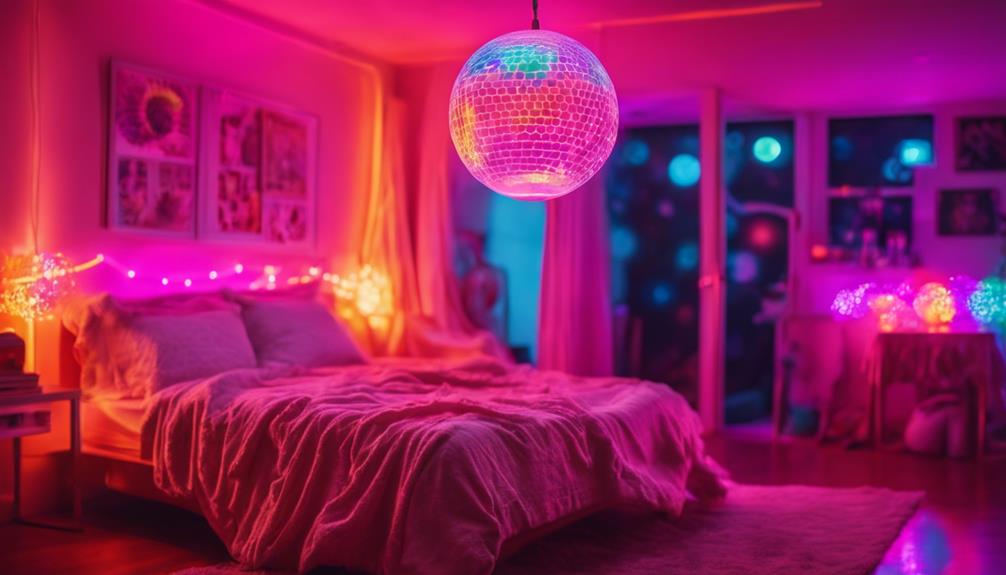
When it comes to lighting, you can really amp up your Y2K vibe with bold choices.
Think neon tube lights for that electric glow, or add a playful touch with disco ball pendant lights.
Color-changing LED strips and glow-in-the-dark ceiling stars will complete your retro-futuristic look while creating an inviting atmosphere.
Neon Tube Lights
Neon tube lights instantly transform your space, infusing it with vibrant colors and a retro-futuristic vibe that perfectly captures the Y2K aesthetic.
These neon lights come in a variety of eye-catching hues like pink, blue, and green, aligning seamlessly with the bright color palettes typical of this nostalgic style. You can use them as wall accents or to outline shapes, words, or unique designs, enhancing the playful and eclectic vibe of your room.
Not only do neon tube lights add a striking visual element, but they're also energy-efficient, often utilizing LED technology. This means you can enjoy their glow without worrying about high energy bills.
By incorporating these lights alongside other retro elements, like string lights or even disco balls, you create a lively atmosphere that celebrates the essence of Y2K decor.
Whether you're aiming for a cozy nook or an energetic gathering space, neon tube lights offer versatility and flair.
Disco Ball Pendant Lights
If you love the vibrant energy of neon tube lights, adding disco ball pendant lights can elevate your space even further with their dazzling reflections and retro charm. These iconic elements of Y2K decor embody the playful spirit of the late 1990s and early 2000s. Their mirrored surfaces create mesmerizing light patterns that can transform any room into a lively atmosphere.
Disco balls serve as both functional lighting and striking decor pieces, showcasing their reflective qualities to enhance your room's ambiance. You can find them in various sizes and styles, making it easy to integrate these versatile additions into cozy bedrooms or lively living areas.
Modern disco ball pendant lights often use LED bulbs, which not only reduce energy consumption but also provide the potential for color-changing effects. This feature amplifies the fun, dynamic vibe associated with the Y2K aesthetic.
Incorporating disco ball pendant lights into your decor can evoke a sense of nostalgia for the pop culture of the era, making them a perfect choice for anyone looking to embrace the Y2K vibe in their interior design. Enjoy the playful sparkle they bring to your space!
Color-Changing LED Strip Lights
Transform your space with color-changing LED strip lights that let you customize the ambiance with vibrant hues, perfectly capturing the playful spirit of Y2K decor. These lights are a fantastic way to infuse your room with energy and style. You can easily install them along walls, ceilings, or furniture to create a dynamic atmosphere that enhances the eclectic vibe of Y2K interiors.
With many color-changing LED strips featuring remote controls or smartphone apps, adjusting brightness, colors, and lighting modes becomes a breeze. This interactivity adds a fun element to your space, making it feel alive. Plus, if you love hosting gatherings, you'll appreciate how these lights can sync to your music, setting a lively ambiance reminiscent of those late-night parties from the early 2000s.
To elevate your Y2K design, consider pairing the LED strip lights with neon or disco-themed decor. This combination amplifies the retro-futuristic feel of your room, transforming it into a statement feature that reflects the essence of the era. Embrace the nostalgia and let your creativity shine with color-changing LED strip lights!
Glow-In-The-Dark Ceiling Stars
For a touch of whimsy and nostalgia, glow-in-the-dark ceiling stars bring a dreamy ambiance to your Y2K-inspired room. These iconic decorative elements not only light up your space but also evoke a sense of wonder, making them perfect for creating an imaginative environment.
During the day, these glow-in-the-dark stars charge up, and when night falls, they emit a soft, soothing glow that transforms your ceiling into a starry sky. You can choose from various sizes and colors to match your decor style.
Arrange them in creative patterns like constellations or random clusters for added visual appeal. Not only do these stars serve as a fun and playful decoration, but they also provide functional lighting, making nighttime feel enchanting.
Most glow-in-the-dark star sets are made from non-toxic, child-safe materials, ensuring they're suitable for all ages. Easy to apply and remove, you can switch up your designs whenever you want.
Incorporating these stars into your space not only reflects Y2K nostalgia but also encourages personal expression, making your room uniquely yours. So, let your imagination soar and light up your nights with these charming decorations!
Decorative Elements
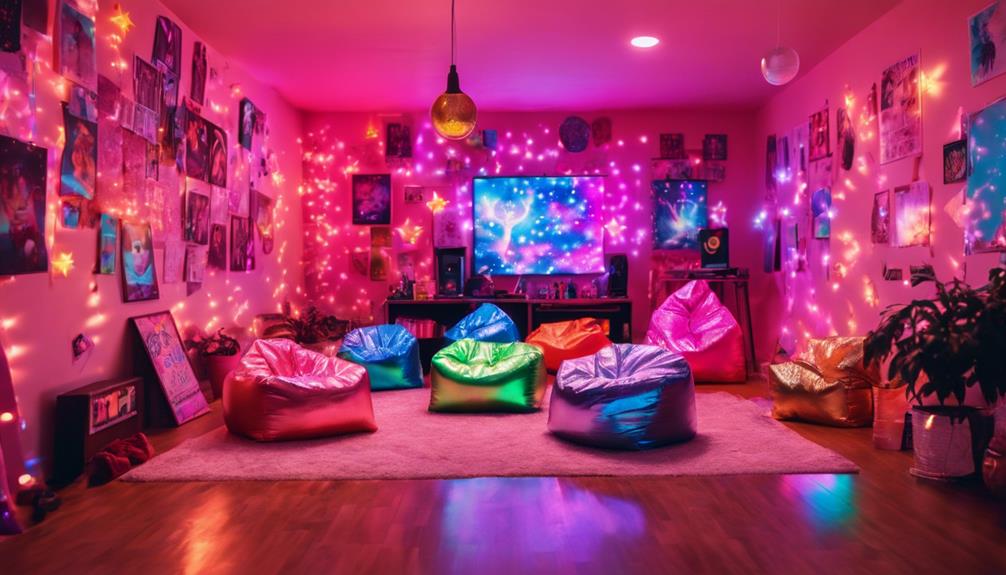
To elevate your Y2K room decor, consider using decorative elements like beaded curtain room dividers and vintage CD wall displays.
These unique touches not only enhance the space but also bring back the playful vibe of the early 2000s.
Don't forget to add plastic bead wall hangings for that extra pop of nostalgia and color!
Beaded Curtain Room Divider
Beaded curtains add a vibrant touch to your Y2K room decor, serving as fun room dividers that enhance both style and separation between spaces. Often made from colorful plastic or glass beads, these curtains can transform doorways or act as wall accents, creating a playful and dynamic visual element. With various designs, including iridescent prints, they capture the retro-futuristic aesthetic of the late 90s and early 2000s.
When you hang beaded curtains, you not only create a whimsical atmosphere but also reflect light beautifully. This feature makes them a popular choice for rooms that incorporate LED or neon lighting, adding depth and interest to your setup. Plus, the wide range of colors, patterns, and lengths available allows you to personalize your space, ensuring your decor reflects your individual style.
Whether you want to divide a room or just add a quirky accent, beaded curtains fit seamlessly into any Y2K decor theme. They're not just decorative; they're an expression of nostalgia and creativity that can elevate your space instantly. Consider incorporating them to make your Y2K room truly unique!
Vintage CD Wall Display
A vintage CD wall display instantly becomes an eclectic focal point, showcasing iconic album covers that capture the musical nostalgia of the Y2K era. To create this eye-catching display, consider using transparent or colorful acrylic shelves that highlight the vibrant artwork of your vintage CDs. This modern approach not only elevates your decor but also aligns beautifully with Y2K aesthetics.
You can arrange the CDs in a grid pattern for a clean look or opt for a themed collage that reflects your personal taste. Both styles add visual interest and personality to your space, making it uniquely yours. For an extra touch of whimsy, incorporate string lights around the display. This simple addition can create a playful ambiance reminiscent of the lively decor characteristic of the early 2000s.
Don't forget that vintage CDs can serve double duty as both decor and functional music sources. You can enjoy the retro sounds while appreciating the nostalgic visuals. Embrace this opportunity to blend the old with the new, transforming your space into a harmonious tribute to the Y2K era.
Plastic Bead Wall Hangings
Plastic bead wall hangings bring a burst of color and whimsy to any room, instantly capturing the playful spirit of Y2K decor. These decorative elements are a quintessential part of early 2000s aesthetics, showcasing vibrant colors and fun patterns that evoke nostalgia.
You can easily create your own plastic bead wall hangings as DIY projects, allowing you to express your personal style. By combining different bead shapes and colors, you can design unique pieces that reflect your creativity.
Common themes for these hangings include butterflies, stars, and geometric shapes, all of which align with the whimsical vibe of the Y2K era. They not only serve as eye-catching decor but can also act as room dividers, adding a fun dimension to your space while maintaining an airy feel.
To enhance the overall look, consider pairing your plastic bead wall hangings with other Y2K decor items, like neon lights and vintage posters. This combination will create a cohesive and vibrant atmosphere, making your space a true reflection of the nostalgic trends you love.
Flooring
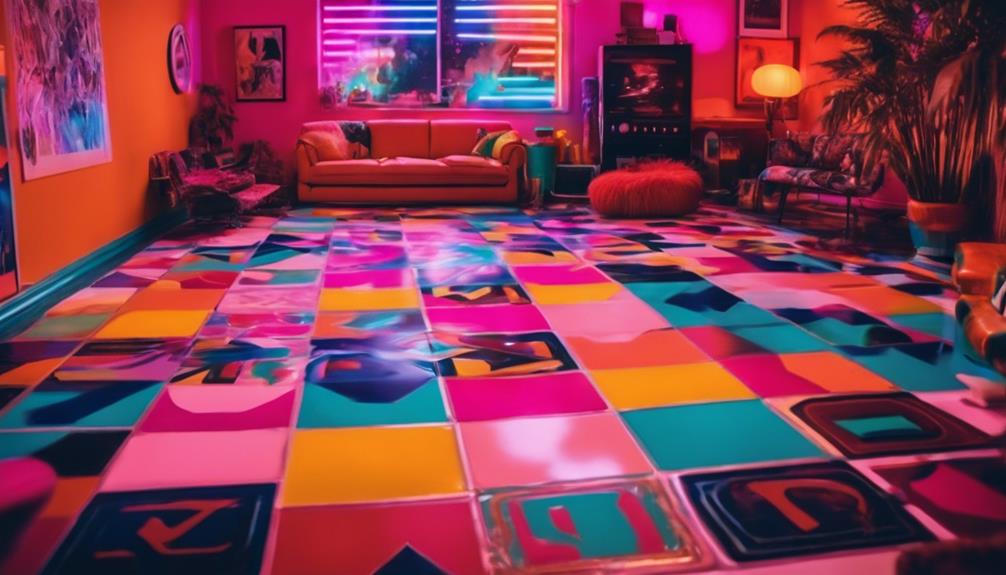
When it comes to flooring for your Y2K-themed room, you've got some fun options to contemplate.
Retro checkerboard vinyl tiles can bring a nostalgic vibe, while faux fur area rugs add a cozy touch.
If you're looking for something playful, colorful interlocking foam tiles can really make your space pop!
Retro Checkerboard Vinyl Tiles
Transform your space with retro checkerboard vinyl tiles that bring a playful and vibrant touch to Y2K room decor. These tiles are a fantastic flooring choice for your Y2K bedroom, capturing the essence of 90s and early 2000s design trends. With classic black-and-white or colorful patterns, they evoke a sense of nostalgia while adding a modern flair.
Not only do retro checkerboard vinyl tiles enhance your room's vibrant aesthetic, but they're also durable and easy to maintain, making them a practical option for any space. You can create eye-catching focal points or define specific areas within your room, enhancing the visual interest and overall design.
Available in various colors and finishes, these tiles allow you to customize your flooring to express your personal style. Whether you prefer bold colors or a more subdued palette, retro checkerboard vinyl tiles can seamlessly fit into your overall Y2K theme.
Faux Fur Area Rugs
Faux fur area rugs are essential for Y2K decor, adding a luxurious touch and cozy feel that perfectly complements the era's vibrant style. These rugs bring a soft, cozy texture to your space, making them a must-have for creating that nostalgic vibe.
Available in an array of colors and patterns, you can easily find a faux fur rug that fits your unique aesthetic, whether you prefer bold animal prints or soothing pastel hues. The plush nature of these rugs not only enhances comfort underfoot but also invites warmth into your room, making it feel inviting and stylish.
Imagine sinking your toes into a soft faux fur rug while lounging in your Y2K-inspired space. Plus, they're easy to maintain, allowing you to enjoy the luxury of faux fur without the hassle of caring for real fur.
Incorporating a faux fur area rug can serve as a statement piece, drawing attention and contributing to the overall maximalist approach of Y2K decor. So, don't hesitate to add this cozy texture to your room—it's the perfect blend of nostalgia and modern flair!
Colorful Interlocking Foam Tiles
Colorful interlocking foam tiles instantly brighten up your space, adding a playful and customizable touch to your Y2K decor. These versatile tiles come in funky colors and countless patterns, allowing you to create a unique flooring design that reflects your personality. Whether you opt for vibrant neon shades or pastel hues, these tiles can transform your room into a nostalgic haven.
One of the best features of colorful interlocking foam tiles is their comfort. They provide a cushioned surface that's perfect for sitting and playing, making them ideal for bedrooms or game rooms. Plus, they're lightweight and easy to install, so you can release your inner DIY enthusiast without needing professional help.
Maintenance is a breeze, too—spills wipe off easily, and if a tile gets damaged, you can simply replace it without hassle. By incorporating these funky foam tiles into your Y2K room decor, you create a cohesive and eclectic aesthetic that complements other elements like bold wall art and funky rugs.
How Can I Incorporate Aesthetic and Indie Room Decor into Y2K Room Decor?
To incorporate Y2K room decor with trendy indie room decor ideas, consider incorporating bold and vibrant colors, retro furniture pieces, and statement accessories. Mix and match vintage finds with modern touches to create a unique and eclectic aesthetic that captures the essence of both Y2K and indie decor trends.
Conclusion
Incorporating Y2K room decor into your space brings a fun, nostalgic vibe that's both trendy and personal.
By blending essential fixtures, creative lighting, and playful decorative elements, you can transform any room into a stylish throwback haven.
Don't forget to pay attention to flooring, as it sets the tone for your entire aesthetic.
So, embrace those retro colors and patterns, and let your creativity shine—you'll love the invigorating look of your new Y2K-inspired space!
